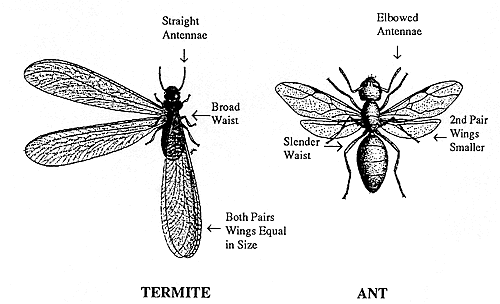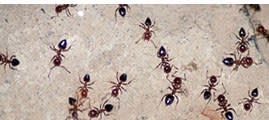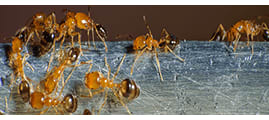
Ant Colonies/Nests and Behavior
Learn about ant colonies (ant eggs and larvae) as well as ant behaviors.
Ants Are Social Insects
In addition to the queens, workers, and male drones, ant colonies include eggs, larvae, and pupae. Laying eggs is the queen's main function. The eggs hatch into grub-like larvae that later change into adult ants. Unfertilized eggs hatch out males, and fertilized eggs become females. Most females are sterile worker ants that do not compete with the queens. They build and maintain the nests, forage for food, feed the queens and developing larvae, and defend the nest. A very few fertilized eggs hatch out new breeding queens. All males are fertile drones, and their only purpose is to breed with the queens.
Ant Nests
Nests protect ants against enemies, offer some protection against extremes of weather. Their nests are often found close to food and water sources Some Ant species nest in the ground, often under concrete slabs or stones. Some species are found in wood, such as fence posts, dead logs, hollow trees, or within buildings.
Termites are also found in wood, but termite damage is much more extensive. Ants cannot eat wood as termites do because they can't digest cellulose.
Ant Behavior
All ants (small and large species) live in colonies, and most build nests, although some species are nomadic. If you see ants foraging in your house or garden, they are worker ants. These workers lay down pheromone trails, cultivate other insects for use as food sources, and swarm to create new nests. Ants may choose to feed on greasy foods, protein foods, or sweet foods. They invade homes to forage for these substances.
Swarmers-Winged Ants
Ant colonies produce winged ants known as swarmers. The swarmers leave the nest to mate and start new colonies. If you see an ant swarm inside a home, it may be a sign that a nest is within the building.
Ants or Termites?
 Termites also develop wings, swarm during the spring, and look
similar to winged ants. They differ in appearance in the following ways: Ants are
thin-waisted and have elbowed
antennae. Termites have antennae that look like strings or tiny beads, and their
waists are thicker than ants' waists.
Termites also develop wings, swarm during the spring, and look
similar to winged ants. They differ in appearance in the following ways: Ants are
thin-waisted and have elbowed
antennae. Termites have antennae that look like strings or tiny beads, and their
waists are thicker than ants' waists.
Pheromones
Worker ants forage, and when they find food, they lay down a pheromone scent trail that tells other worker ants where to locate the food. Ants that find the food at the end of the trail reinforce the pheromone signal on the return trip to the nest; once the food source is exhausted, the pheromone trail eventually dissipates.
Relationships with Other Insect Pests
Some ant species develop relationships with insects that are detrimental to plants. For example, Aphids and Mealybugs secrete a sticky, sweet substance known as honeydew. Since honeydew is a type of Ant superfood, Ant colonies will defend the insects that provide this food. Sometimes ants will even relocate their insect friends, moving them to new food sources. Most insects cultivated by ants damage garden plants by feeding on sap or eating leaves, making it even more important to control outdoor Ant populations.
Ant Identification
Click on the Ants below for more information on identification, pictures, habits, and recommended products and procedures. You will find descriptions and recommendations for control of the more common household ants as listed below.
















